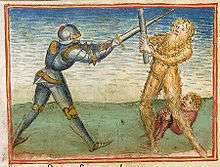Sigenot

Sigenot is a Middle High German poem, composed no later than 1300, and probably developed in the Swabian-Alemanic dialect area. Its subject matter is the encounter and combat of Dietrich of Bern (Theoderic) with the eponymous giant Sigenot.
Versions
The poem exists in two versions: the so-called elder Sigenot (älterer Sigenot), which is very short and probably represents shortened version of a longer text which is also the basis of the younger Sigenot (jüngerer Sigenot).
In the älterer Sigenot, Dietrich awakens the giant Sigenot in the forest by kicking him. The giant then recognizes Dietrich as the slayer of Hilde and Grim, two giant relatives of his, and forces Dietrich to fight him, despite a sudden reluctance (zagheit) on Dietrich's part. Dietrich is thrown into a dungeon. Sigenot now heads to Verona to defeat Hildebrand, and, encountering him in the forest, takes him prisoner as well. However, once Hildebrand has been dragged to Dietrich's prison, he is able to free himself, slays the giant and frees Dietrich with the help of the dwarf Eggerich. The two heroes then return to Verona.
The jüngerer Sigenot adds a beginning in which Hildebrand tells Dietrich about Sigenot and warns him not to go into the forest to fight the giant. Then, before encountering the giant, Dietrich fights a wild man who is keeping the dwarf Baldung captive. As a reward, the dwarf gives Dietrich a protective jewel and directs him to Sigenot. Dietrich fights Sigenot and is taken prisoner. Sigenot throws Dietrich into a snake pit, but the jewel protects him. Hildebrand, now worried by Dietrich's long absence, sets out to find him: on the way he encounters Sigenot and is taken prisoner. Left alone, Hildebrand frees himself and dresses in Dietrich's armor. He then slays Sigenot and frees Dietrich with Eggerich's help.
The poem may connect to Dietrich's captivity among giants, as referenced in the Waldere: Heinzle suggests that it was created in the 13th century under the influence of this traditional story. The text also makes reference to Dietrich's battle with Hilde and Grim, which is told in the Thidrekssaga and referenced in the Eckenlied, but about which no poem survives.
Textual tradition
There are eight surviving manuscripts, dated from the early 14th to the late 15th century, and at least 21 prints dating between 1487 and 1661. This makes Sigenot the most successful representative of the Dietrich epics. In spite of its relative success, the poem is not regarded very highly in modern philology. It is still of some importance as a witness of the German tradition of the Dietrich legend, specifically because its mention of Grim and Hilde, who are otherwise only found in the prose tradition of Thidrekssaga.
Count Gottfried Werner von Zimmern in 1514 commissioned a cycle of frescoes in Wildenstein Castle, of which 32 survive. The late manuscript Cod. Pal. germ. 67. of c. 1470 also contains a large number of illustrations from the workshop of Ludwig Henfflin.
References
- Grünewald, Dietrich: Sigenot - Daumenkino des Mittelalters? In: Eckart Sackmann (ed.): Deutsche Comicforschung 2006. Comicplus, Hildesheim 2005, ISBN 3-89474-155-4, 7-16.
- Heinzle, Joachim (ed.): Der ältere und der jüngere "Sigenot" : aus d. Donaueschinger Handschrift 74 und dem Strassburger Druck von 1577 in Abbildungen. Göppingen: Kümmerle. 1978. ISBN 3-87452-425-6.
- Schneider, H., Wisniewski, R.: Deutsche Heldensagen. Sammlung Göschen, Band 32. Berlin, Zweite Auflage 1964. Walter de Gruyter & Co.